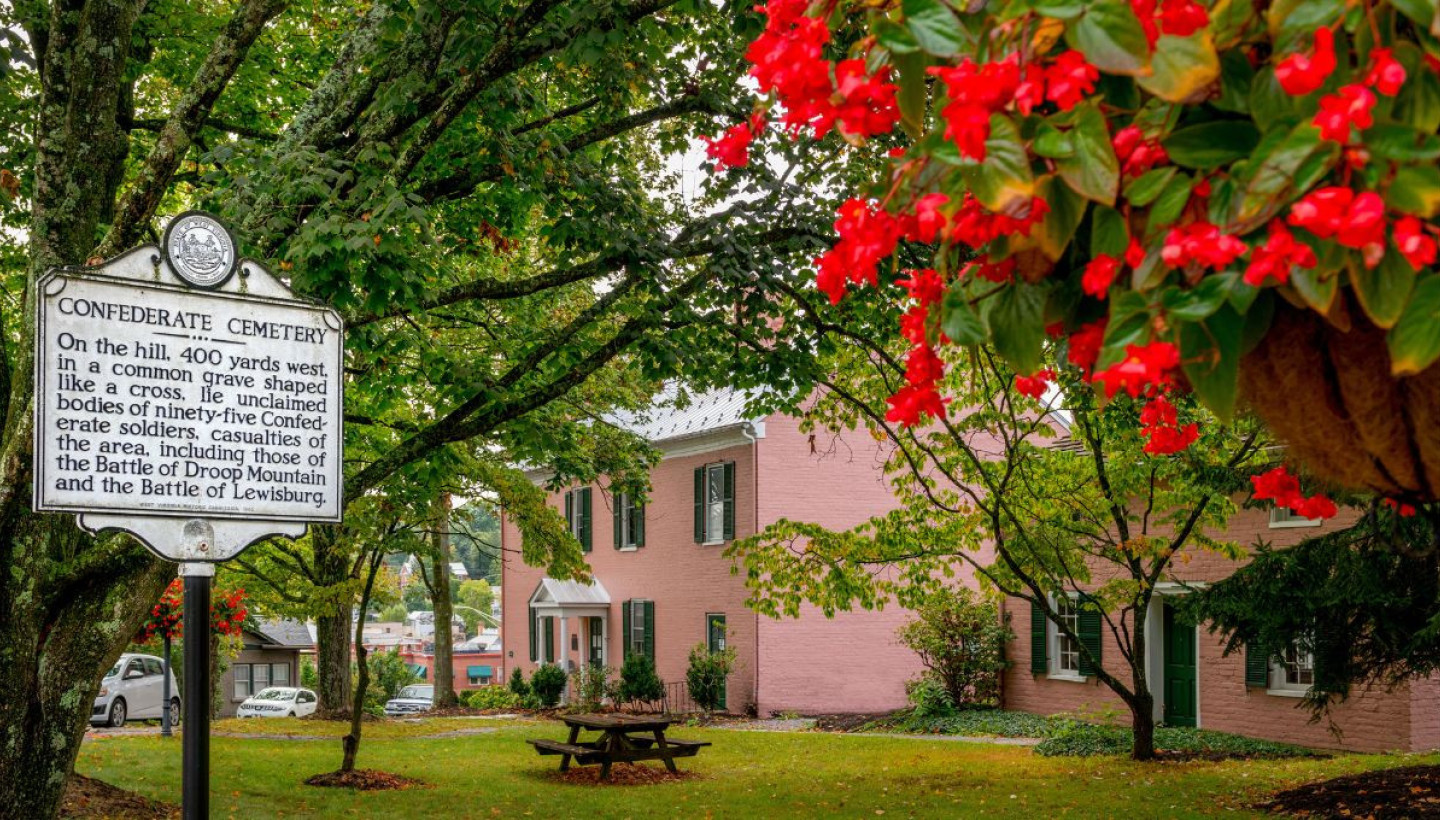Civil War History in the Greenbrier Valley
Battles in streets, families divided. This was the Greenbrier Valley during the Civil War.

Battles in streets, families divided. This was the Greenbrier Valley during the Civil War.
That past is still tangible. When I first moved to the Greenbrier Valley, I was astounded at how up close and personal I was to Civil War history. I could walk right up to a church and see where it had been hit by a cannonball, while people drove by on their everyday rounds. The very streets I strolled in downtown Lewisburg had been trod by troops. -Belinda Anderson, writer
Wall repairs from that cannon ball strike during the Battle of Lewisburg in May 1862 still can be seen on the southwest wall of John Wesley Methodist Church.
At the Old Stone Presbyterian Church, one of the downtown buildings used as a hospital, the victorious Union commander refused services for the Confederate dead that filled the sanctuary. The bodies were thrown into a trench along the south wall of the church. Later, the remains were reburied in what is today called the Confederate Cemetery, a common grave mounded in the shape of a cross on a hill above the church.

Spectators watched the Battle of Lewisburg from the balcony of the house now known as the North House Museum, which today houses Civil War artifacts and exhibits as part of the museum’s comprehensive history of the Greenbrier Valley.
Soldiers’ graffiti can still be seen inside the nearby Supreme Court of Appeals of Virginia Law Library, used as a Civil War hospital. Next to the building is a relocated 1835 building that served as quarters for the enslaved people of the Johnson Reynolds family. The building is a reminder of the critical issue that would divide the nation.

Supreme Court of Appeals of Virginia Law Library
The fortunes of war shifted back and forth in the Greenbrier Valley. A year after the Battle of Lewisburg, the Confederates successfully fought off the Union soldiers in the Battle of White Sulphur Springs, also known as the Dry Creek Battle.
Just as everyday life in downtown Lewisburg is conducted where troops once clashed, in White Sulphur Springs, the historic battleground where 350 lives were lost is now a place where people shop for groceries, buy gas, dine out and wash their cars. A historical marker at the intersections of routes 60 and 92 memorializes the two-day encounter.
Visitors to The Greenbrier resort in White Sulphur Springs are staying on grounds occupied at various times by both the Union and the Confederacy. The resort also was used as a hospital and military headquarters.

Drivers on Route 12 in Alderson are passing in the vicinity of the ferry used by both Federal and Confederate troops to cross the Greenbrier River. Perhaps the most famous to cross was a brigadier general who became the 19th president of the United States – Rutherford B. Hayes.
Another famous Civil War participant – Confederate General Robert E. Lee’s horse Traveller, was raised around Blue Sulphur Springs.

Confederate General Robert E. Lee and horse Traveller
Much of the Greenbrier Valley supported the Confederacy. But there also were conflicting loyalties within individuals as well as within families. A young man of 23 from Ronceverte named Alfred Mallory Edgar began keeping a journal as he volunteered for service in the Confederate Army. “I am following what I honestly believe to be my duty,” he wrote. And yet, “The institution of slavery I believe to be a ‘national evil,’ … and if a bloody civil war is God’s appointed way to end it, He will overrule and control all secondary causes …” Edgar was wounded and became a prisoner of war. He survived and later married and moved to Pocahontas County.
The 1810 home in which Edgar grew up is now part of a distinctive Queen Anne-style house with later Victorian additions that stands on Walnut Street in Ronceverte. It is now known as The Hollerwood House, offering lodging and venue space.
A letter written to Edgar from relative James L. Anderson in 1864, while Edgar was still a prisoner, sends a message that underscores why history matters:
“Your letter gave us the first intimation that we had near and dear friends on both sides of the bloody contest … Hoping that this war may be brought to a speedy close and that friends may again be reunited, all enmities reconciled.”

Captain Alfred Mallory Edgar's Civil War memoir
The North House Museum of the Greenbrier Historical Society offers many opportunities to explore more Civil War history, including a “Conflict & Consequences” exhibit. In addition to the exhibits and tours within the facility, the museum also offers history walks, including one that visits the Old Stone and Confederate cemeteries.
Researched and written by Belinda Anderson.
Belinda Anderson has been hooked on history since a college class where she read oral histories of 19th-century mill workers, inspiring her to conduct an oral history interview with her grandfather about the Great Depression. Since then, she has written numerous articles on a variety of historical subjects such as The Greenbrier Ghost and Dorothy Draper, The Greenbrier Decorator.
Her work includes a history booklet series commissioned by Alderson Main Street, filled with such history nuggets as the story of the Alderson native who became a Jazz Age sensation and how Alderson was founded because of forbidden love.
Want to get connected? Sign up to receive our monthly GBV Insider’s Guide enews, packed with seasonal trip ideas. For a closer look at what’s going on, opt into our Weekly Calendar of Events enews—it’s a 7-day snapshot of the week ahead.